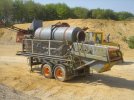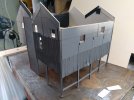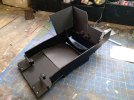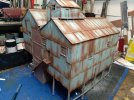Dave
Western Thunderer
The camera idea is on the back burner and a problem there, apart from the cost, is that they aren't designed to focus as close as I would need. It would have to be inside the building and so at the most the camera would be only a couple of inches away from the chute. It's something that I didn't think about yesterday.
The Archimedes screw would certainly work but the loading would still need to be observed.
The magazine idea is interesting and I may have a go if my own idea doesn't work.

The inner tube is designed to hold the same volume of material as the wagons that are to be loaded. It is a tight enough fit in the outer tube to prevent load material from getting between the tubes but loose enough to be rotated and has a single slot cut in it.
The inner tube is connected to a motor/gearbox and the outer tube is fixed to the hopper.
The outer tube has a slot at the top that matches the slot in the inner tube.
With the inner tube's slot facing upwards the tube is filled with the load material.
As the tube revolves through 90 degrees the hopper inlet port is cut off from the tube and so nothing more can pass from the hopper.
By revolving the tube further, the exit port in the outer tube is revealed and the load drops into the wagon.
As the tube is made to hold the same volume as the wagon it will not be necessary to observe the loading as the wagon is guaranteed to be full and cannot be overfilled as material cannot continue to flow from the hopper.
The addition of microswitches and cams ought to allow a single button to be pressed to set it in motion and it then stop once the tube is refilled and ready for the next wagon to be positioned.
That's the theory but what actually happens to the material when the tube comes round to close the inlet port is another thing. It could jam. It could bend the edge of the tube. I guess I will just have to build it and see.
The Archimedes screw would certainly work but the loading would still need to be observed.
The magazine idea is interesting and I may have a go if my own idea doesn't work.
The idea that I described cannot be done to excess. Perhaps this poor sketch on the back of an envelope may help explain it.I would definitely work on the “measured amount” approach, were I trying to develop a motorised loader. The question is then one of how to fill the measure, which can be done to excess, as the extra will then fall back in the tray.
If you do it manually, that might be a simple solution

The inner tube is designed to hold the same volume of material as the wagons that are to be loaded. It is a tight enough fit in the outer tube to prevent load material from getting between the tubes but loose enough to be rotated and has a single slot cut in it.
The inner tube is connected to a motor/gearbox and the outer tube is fixed to the hopper.
The outer tube has a slot at the top that matches the slot in the inner tube.
With the inner tube's slot facing upwards the tube is filled with the load material.
As the tube revolves through 90 degrees the hopper inlet port is cut off from the tube and so nothing more can pass from the hopper.
By revolving the tube further, the exit port in the outer tube is revealed and the load drops into the wagon.
As the tube is made to hold the same volume as the wagon it will not be necessary to observe the loading as the wagon is guaranteed to be full and cannot be overfilled as material cannot continue to flow from the hopper.
The addition of microswitches and cams ought to allow a single button to be pressed to set it in motion and it then stop once the tube is refilled and ready for the next wagon to be positioned.
That's the theory but what actually happens to the material when the tube comes round to close the inlet port is another thing. It could jam. It could bend the edge of the tube. I guess I will just have to build it and see.










 ):
):